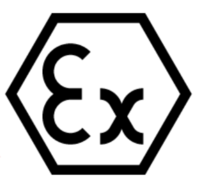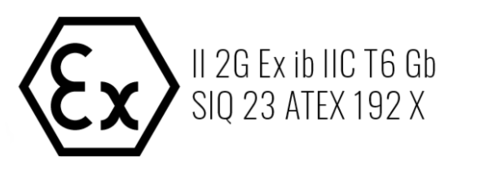Template:ATEX
ATEX
ATEX certification is given to equipment that has gone through rigorous testing outlined by European Union directives. Products that are ATEX compliant have been proved safe to use in specific environments with explosive atmospheres, according to the zone/s they are certified to be used in.
Description
The European Union has mandated that ATEX compliance is necessary wherever a potentially explosive atmosphere exists in order to keep workers safe. These atmospheres are characterized by possessing three things.
- Air
- An ignition source
- One of the following three substances:
- Flammable gases
- Mists or vapor
- Combustible dust
Products that have received ATEX certification will have the official “Ex” badge, indicating they are safe in explosive atmospheres.
Non-ATEX/IECEx safe computing devices used in hazardous areas could be an ignition source, so it is critical that ATEX/IECEx certified computing devices are used in those areas. If they are not, the situation immediately poses great risk to workers’ safety. That’s why we’ve built rugged computing devices that are ATEX/IECEx certified.
Meanings of Letters and Numbers
II - Equipment Group
2 - Equipment Category
G - Enviroment
Ex - Explosion Protection
ib - Type of Protection
IIC - Gas Group
T6 - Temperature Class (T1 - T6)
Gb - Equipment Protection Level
II: There are two equipment groups - Group I, which concerns mines and is very restrictive due to the highly volatile methane gas and dust present, and Group II, which relates to all other above-ground industries.
2: There are three area category types, with Category 1 requiring a very high level of protection and defined as an area having a permanent or prolonged risk of explosions (Zone 0), Category 2 which requires a high level of protection and has a frequent risk of an explosive mix being present in the air (Zone 1), and Category 3, specified as requiring a normal level of protection with a small chance of an explosive mix forming (Zone 2).
G: This specifies the type of explosive atmosphere. D for dust and G for gases.
Ex: This means the equipment is explosion-proof.
ib: This indicates the type of protection. Intrinsic safety ("ib") is a technique used to ensure that electrical and electronic equipment can be used in explosive atmospheres without the risk of ignition.
IIC: This indicates the level of protection against specific types of explosive gases. Group IIC certification is the highest possible, so also covers the other levels.
T6: Different substances may combust at different temperatures. The lower the combustion temperature is, the more dangerous the substance is. Therefore, each piece of equipment used in an explosive environment is classified according to the maximum surface temperature it generates. The maximum surface temperature of the equipment should always be well below the ignition temperature of the gases present. If Max Surface Temperature of Equipment does not exceed 85 °C its certified for T6 and is the highest possible rating, so also covers other classes.
Attachments
Certification number: BTSXXX
EN1 (EN1 number): BTSXXX
EN2 (EN2 number): BTSXXX
Disclaimer
Any of the trademarks, service marks, collective marks, design rights or similar that are mentioned, used or cited in the articles are the property of their respective owners.

